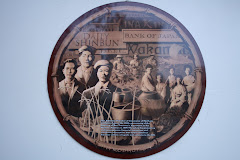
On a sunny Saturday afternoon in Japantown's Peace Plaza different languages are carried on the wind that gusts between the separated buildings of the Japan Center, and the tongues announce the theme of the day: the intermingling of cultures, ages; and real life and fantasy. People lounge underneath the Peace Pagoda, and people sit on the circular cement benches wrapped around cement cylinders holding flowers or a tree. Kids use cement structures as hiding spots during games of hide-and-seek, and people make their way from the Miyako Mall to the Kintetsu Mall and vice-versa.
At first the conversations vary wildly, including topics such as the difference in Californian and Japanese marijuana laws, the San Francisco Chronicle's Sept. 24 article examining possible water rationing in the Bay Area's future, what to drink that evening, and a man riding a bike naked on the Embarcadero. Oakland resident and University of San Francisco student Mark Devera shared the secrets of Japantown shopping.
"The Kinokuniya Bookstore is always well-stocked," Devera said. "And they have a huge selection of Japanese comics."
Daniel Reidy, who lived in Japantown for four years in the 1970's and now visits regularly, recommended the Soko Hardware store, where "they have great old, traditional Japanese tools." Reidy lamented some of the changes Japantown has undergone over the years such as the loss of a distinct architectural style, the recent closing of Japantown Bowl, and the Kabuki Springs and Spa losing its authenticity and becoming like any other spa.
All attention quickly shifted to dancers on an elevated portion of cement next to the Peace Pagoda. Previously a young man and woman had been dancing to music from their boombox and they had been receiving a fair amount of looks from the crowd in the Plaza, but two new dancers arrived and the party really began. Both of the newcomers were young women, one of whom wore a green wig, a small red hat, a short red dress and red stalkings. The other fashioned a purple halter-top, and a short dress of the same color. She mouthed words into a golden microphone as she dances her way onto the raised cement area where the other dancers continue to perform unperturbed.
"Who are these people?" asked Daniel Reidy as he squinted through his thick glasses and settled his eyes on the dancers with a perplexed glare.
"I don't know," I answered and excused myself to go find out. I sat and watched while the dancers mechanically jumped around and flung their arms about like robots until they finally tired. I waited longer for answers while the exhausted dancers obliged some adoring fans by taking photographs with them.
Finally, the answer comes. They are "costume-players'" or as they called it, "cosplayers." What is a cosplayer? It is someone who dresses like an anime character and goes around "and just has fun," explained Darla Amyx, the cos-player dressed in red.
"You can purchase the costumes on Ebay or you can make your own," advised Asha Blackwell, the green-haired cos-player. This particular day, Asha and Darla were dressed like characters from the anime Macross Frontier, but there's all different costumes and characters, they assured me.
And why did they come to Japantown? It was only one of their stops during their of cos-playing, but they knew they had to pay homage to anime's birthplace of Japan by dancing through Japantown. Although they didn't know the other anime dancers, Asha and Darla felt comfortable coming to Japantown to cos-play because they knew fellow cos-players would likely be there. The other two who made up the momentary foursome were Kaela Tucker and Max Hall.
"We're not cosplayers," Hall said. "Dancing without the costumes is just dancing." Hall and Tucker usually come out every weekend to Japantown's Peace Plaza and dance to the music of The Melancholy of Haruhi Suzumiya, a video game. They normally appear as cosplayers, although their costumes weren't available this weekend because they were dirty, Tucker explained. They come to Japantown for the same reason that Amyx, Blackwell, and many others come: Japantown is the closest they can get to Japan without travelling across the Pacific Ocean.




No comments:
Post a Comment